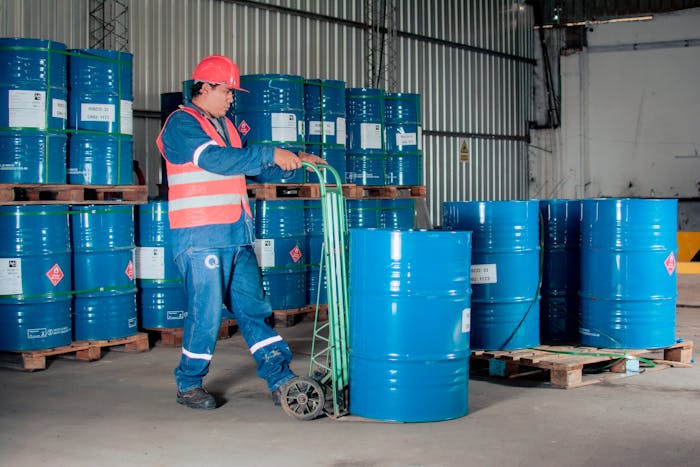Explore how eLogii route optimization software can enhance your inventory management and increase your bottom line by optimizing your deliveries.
Centralized inventory means managing all your stock in one central warehouse or database, rather than spreading it across many locations.
Think of an omnichannel eCommerce fashion retailer with both an online store and a physical shop. Instead of managing inventory separately for each, they can use one centralized system to oversee all stock from a single warehouse.
In inventory management, centralized systems help make operations more efficient and improve control over inventory.
In this post, we will explain how centralized inventory works. We'll compare it to decentralized inventory, and help you decide if it's the right choice for your business.
Key takeaways
- Centralizing inventory means keeping all your stock in one location. Whether you sell online or through physical stores, this makes it simpler to track and manage your products.
- A centralized approach is excellent for straightforward stock management. Yet, decentralizing might be better if your customers have a variety of locations. Or, if your products need different storage conditions, it can also be useful.
- The benefits of centralized inventory management include simpler stock control, cost savings, accurate tracking, and streamlined shipping and order fulfillment.
- Drawbacks of centralizing inventory include longer delivery times for distant customers, higher shipping expenses, increased vulnerability to disasters, and reduced flexibility.

What does centralized inventory mean?
Centralized inventory involves managing all your stock in one location rather than across multiple warehouses or storage facilities.
Businesses often find it simpler to gather all their stock in one place. It makes managing inventory levels, fulfilling orders, and tracking product movement easier. That is especially true for companies with multichannel retail.
Centralized inventory is the "control center" for all your available items and sales channels.
This central hub ensures that your business is always aware of stock levels, locations, and quantities available for sales or replenishment. Despite consolidating everything in one central location, you can still organize your inventory effectively to facilitate easy access to products.
Centralized inventory simplifies tracking inventory turnover and reduces errors. That significantly improves day-to-day operations and ensures efficient management of stock-keeping units (SKUs). With centralized inventory, there's no need to search through multiple inventories or data sheets, streamlining the process and keeping everything organized.
What is the process of centralized inventory management?
Imagine you operate a small online store specializing in trendy sneakers. You have your main website, sell on various eCommerce platforms, and run a small physical store.
For seamless operations, the essential component here is a centralized inventory system.
Here's how it works: You gather your entire collection of sneakers into a single central warehouse. This warehouse holds all the items you sell across all your sales channels.
Whenever a customer orders through your website, an eCommerce marketplace, or your physical store, the inventory levels at the central warehouse are immediately updated. These real-time updates ensure a consistently accurate record of your store's inventory.
A centralized inventory system helps you avoid overselling. It also helps avoid running out of stock and redesigns your entire order fulfillment process.
Suppose a customer orders a pair of sneakers from your website and another pair from an eCommerce marketplace. Both pairs are picked, packed, and shipped from the same warehouse. That simplifies inventory management because you don't have to manage many distribution centers or shipping processes.
Comparison: Centralized vs. Decentralized Inventory
Now that we've discussed centralized inventory, let's explore another approach to managing your stock: decentralized inventory (or distributed inventory).
Centralized inventory manages all logistics, including inventory and order management, from a single hub. In contrast, decentralized inventory spreads these functions across many warehouses or storage facilities.
Decentralized inventory is beneficial when customers are spread across a wide area. It allows you to store products closer to their locations, resulting in quicker delivery and lower shipping costs.
Yet, managing decentralized inventory can be more challenging in terms of warehouse management.
When you're managing stock across different locations, it can become more complex and may lead to higher inventory costs. On the other hand, centralized inventory also has its drawbacks, which I will discuss in the next section.

Advantages and disadvantages of centralized inventory
Before determining if centralized inventory is the best choice for your needs, it's important to consider both the benefits and potential drawbacks of this approach.
Pros of centralized inventory
- Streamlined inventory and order management. With a centralized inventory, everything is consolidated under one roof. It eliminates the need to juggle multiple tasks. Say goodbye to managing countless inventory sheets or warehouse locations. Instead, enjoy a simplified inventory process by managing everything in a single location.
- Cost savings. Opting for a centralized approach can result in inventory cost savings that relate to managing multiple warehouses or storage facilities. It eliminates the need for duplicate inventory or excess safety stock across many locations. It thereby optimizes your inventory holding costs.
- Enhanced accuracy. Managing inventory from a single location reduces the likelihood of discrepancies and errors. This results in more precise inventory data, simplified stock audits and cycle counts, reduced inventory loss and shrinkage, and improved tracking of product movement throughout the supply chain.
- Integrated shipping and fulfillment. Fulfilling orders becomes streamlined when all products are housed in a single location. Picking, packing, and shipping operations all occur in one centralized facility. That reduces order processing time and improves customer satisfaction.
- Simplified analysis and forecasting. Data management becomes effortless with a centralized inventory. It consolidates your data for stock level management, trend identification, and accurate future predictions, all within a unified platform. That makes leveraging data for decision-making straightforward and efficient.
Cons of centralized inventory
- Extended delivery times. Utilizing a centralized warehouse can result in longer shipping distances to reach customers spread across different locations. These increased transit times could potentially impact customer satisfaction negatively.
- Increased shipping expenses. A centralized setup may result in higher shipping costs. That is due to the need for items to travel longer distances to reach customers or suppliers based on their locations.
- Vulnerability to single points of failure. If an unexpected disaster or technical issue occurs at your central warehouse, it could disrupt your entire inventory management system. That can impact your overall business operations.
- Reduced flexibility. A centralized inventory system may face challenges in accommodating diverse product types or regional storage needs. That may not be suitable for every business model.
- Risk of stockouts. Centralized inventory systems may experience stockouts in certain scenarios. Namely, restocking can take longer when suppliers are located farther away from a single warehouse.

Is Centralized Inventory a Good Fit for Your Business?
Now you might be considering if centralized inventory is the ideal inventory management system for your business. It could be a great match if your business operates across multiple sales channels. These could be a combination of brick-and-mortar shops and online stores.
Centralized inventory can also be highly effective when you need a simpler, more efficient method to manage your stock. All that while maintaining consistency and accuracy across all your sales channels.
For businesses operating both online and physical storefronts, centralized inventory management is particularly valuable for staying organized. It can also help you avoid issues like overselling or stockouts of popular items. With centralized inventory, you can efficiently track product movement across all channels. That enables easier trend identification, reordering management, and planning of promotions or sales.
Instances When Centralized Inventory Might Not Be Suitable
There are scenarios where centralized inventory may not be the most suitable option. That is especially true if your customers are located across large geographical areas. In such cases, relying on a single warehouse could result in longer delivery times and increased shipping expenses.
Or, you may want to explore decentralized inventory management with many warehouses to expedite delivery and reduce costs. Additionally, if you're handling a diverse range of products that require different storage conditions or specialized handling, you should manage them regionally. Do that through a decentralized inventory approach, which could be more practical.
Explore how eLogii software can enhance business deliveries and optimize driver operations
As you reflect on the inventory management strategies we've discussed and how they could benefit your business, think about further optimizing your delivery operations. eLogii route optimization software makes this process easy and efficient.
eLogii's software is a robust tool that streamlines different aspects of the delivery process. These include route optimization, real-time delivery tracking, and driver monitoring.
Picture having all the tools to efficiently manage your drivers and deliveries within one user-friendly platform, crafted with your business and customer experience in focus. This comprehensive solution includes everything necessary to streamline your entire delivery process. It features everything from route planning to providing customers with real-time ETAs.
It could be the ideal complement to enhance your centralized inventory strategy and boost your daily workflow.
